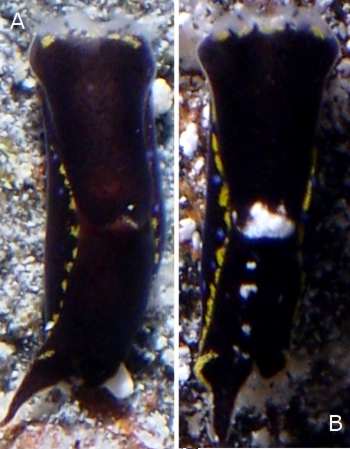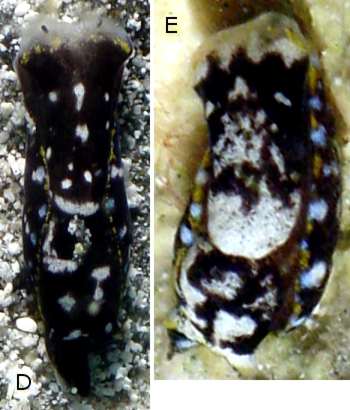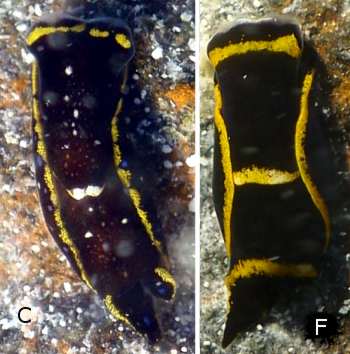Colour variation in Chelidonura berolina
March 15, 2004
From: Marina Poddubetskaia


Dear Bill,
Here is a set of photos showing the colour variation in Chelidonura berolina within one restricted area, near Anne DuPont boat in the Southern Bahamas. All the specimens were found on the sand, on shallow bottoms.
Bill, do you think the Photo F is C. berolina too ? I photographed 2 specimens like this one.
Great Exuma, Bahamas, Western Atlantic. Site: Stocking Island, Hole n°2
Depth: 1m
Photos A, B, D, E: February 03, 2004
Size: A = 7-8mm, B = 5-6mm, D = 6mm, E = 5mm
Photos C, F: February 01, 2004
Size: C = 8-9mm, F = 10-11mm
Photos: Marina Poddubetskaia - Nembro website
Best wishes,
Marina.
nembro@nembro.info
Poddubetskaia, M., 2004 (Mar 15) Colour variation in Chelidonura berolina. [Message in] Sea Slug Forum. Australian Museum, Sydney. Available from http://www.seaslugforum.net/find/12418
Dear Marina,
Thanks for this collection of photos showing the colour variation in C. berolina. This is indeed more evidence showing this species should really be identified as the eastern Atlantic species C. africana. I think we can say that the basic colour pattern is black with a yellow border to the parapodia and posterior shield and a yellow band across the head, some distance back fron the edge. Often the yellow lines are broken into a series of spots, and in some cases the yellow is absent. There are blue spots forming a sub marginal row on the parapodia and there can be blue spots on the inside of the 'tails' of the posterior shield. The blue spots can sometimes be absent, and sometimes are greatly enlarged.
There is a wide translucent white band across the front of the head shield. In most animals, but not all, there are white specks and patches scattered over the body. Sometimes the white predominates, producing an animal which could be best described as white with black speckling. There is usually a large white patch on the posterior tip of the head shield, which can sometimes be yellow or edged in yellow. Colin Redfern's photo [#12445] also suggests that the background colour can at times be brown rather then black.
You ask whether the animal in Photo F is the same? I am sure it is a colour variety. If you look at one of Anne Dupont's earlier messages [#9573] you will see an animal with similar broad transverse orange-yellow bands, but in that case the body is covered in white speckling, and is associated with a population of other animals with little sign of yellow on their bodies.
Re-looking at the Marcuses' descriptions, it is possible that C. hummelincki is a colour form of C. berolina, the difference I mentioned in the posterior 'tails' may be a result of preservation. However, as I said previously [#9573], the lack of any information on its living colour make its identification impossible.
With this extra information I think it is worth discussing the identity of this species in more detail. I have done this in a separate message [#12457]. I have little doubt that this is the same as the eastern Atlantic species Chelidonura africana.
Best wishes
Bill Rudman
Related messages
-
Chelidonura africana from Croatia
From: Tom Turk, August 24, 2006 -
Chelidonura africana? from Cozumel, Mexico
From: James Lyle, August 31, 2005 -
Aglaja hummelincki or Chelidonura africana?
From: Anne DuPont, August 29, 2005 -
Melanochlamys? from Italy
From: Alberto Piras, June 4, 2005 -
Chelidonura africana, C. hummelincki & C. berolina
From: Colin Redfern, March 15, 2004 -
Chelidonura berolina = C. africana [2]
From: Bill Rudman, March 15, 2004 -
Chelidonura berolina from Bahamas [2]
From: Anne DuPont, January 5, 2004 -
Chelidonura berolina from Bahamas [1]
From: Anne DuPont, January 5, 2004 -
Chelidonura berolina = C. africana
From: Bill Rudman, January 5, 2004 -
Re: Chelidonura africana from the Azores
From: Juan Lucas Cervera, May 27, 2003 -
Chelidonura africana from the Azores
From: Terry Gosliner, May 24, 2003 -
Chelidonura berolina? from the Bahamas
From: Anne DuPont, April 14, 2003
